Marketing Crisis and Reputation Management: Dove's Campaign Report
VerifiedAdded on 2022/11/10
|8
|2306
|250
Report
AI Summary
This report analyzes the marketing crisis surrounding Dove's "Real Beauty" campaign, examining the nature of the controversy, which stemmed from perceived racism and insensitivity in its advertising. The report identifies the key individuals and organizations involved, including Dove, Unilever, and Ogilvy & Mather, and details the economic, social, and historical context of the campaign. It explores the necessity of shutting down communication and Dove's handling of the situation, including its apology and removal of the campaign. The analysis assesses Dove's demonstration of online knowledge during and after the controversy, highlighting both successes and failures. The report concludes by outlining the lessons learned from this case study regarding dealing with negative online reactions, emphasizing the importance of careful content selection, diverse perspectives, and thorough competitor analysis before launching social media campaigns. The report uses the case study to underscore the impact of negative comments on brand image and sales, and the importance of ethical considerations in marketing.
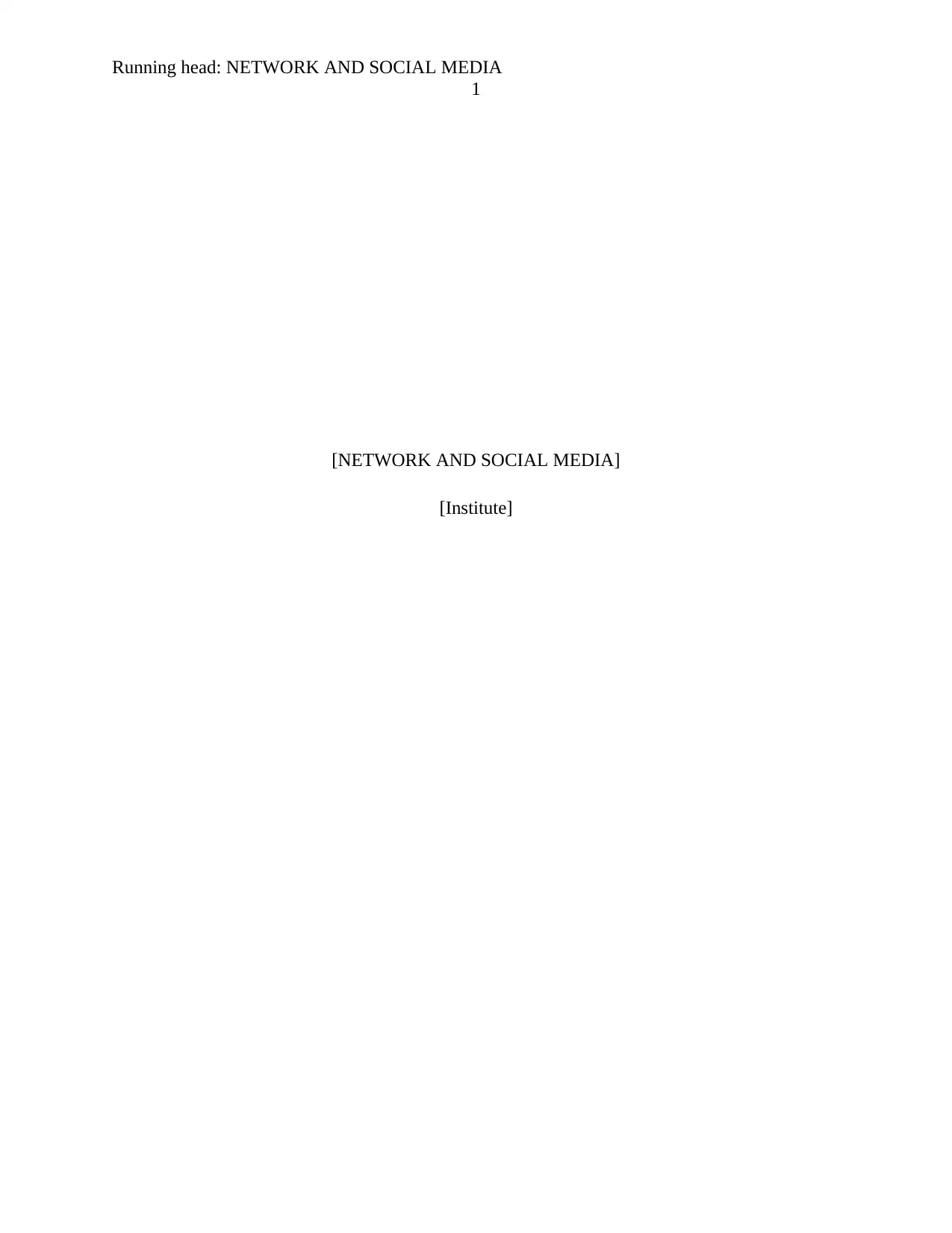
Running head: NETWORK AND SOCIAL MEDIA
1
[NETWORK AND SOCIAL MEDIA]
[Institute]
1
[NETWORK AND SOCIAL MEDIA]
[Institute]
Paraphrase This Document
Need a fresh take? Get an instant paraphrase of this document with our AI Paraphraser
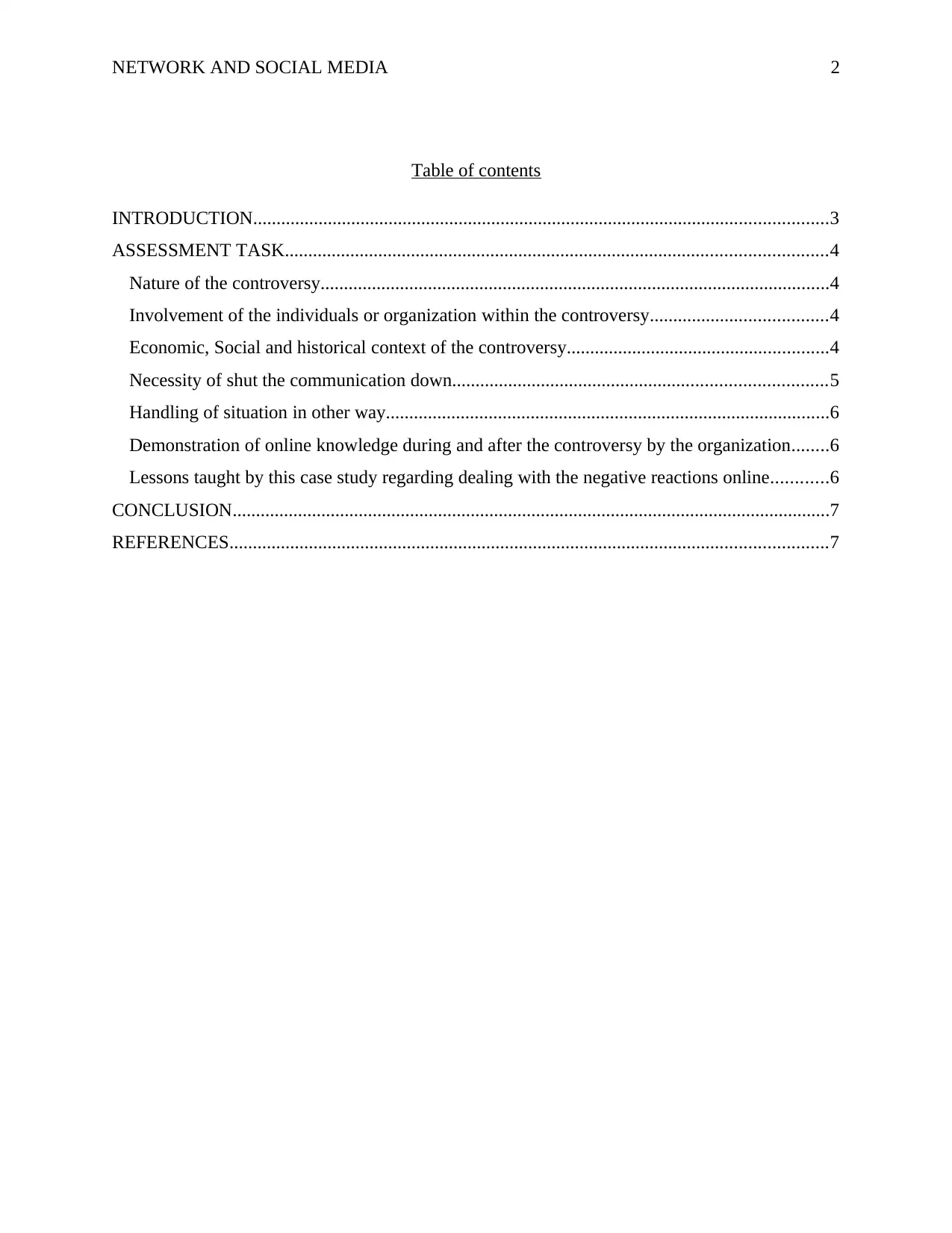
NETWORK AND SOCIAL MEDIA 2
Table of contents
INTRODUCTION...........................................................................................................................3
ASSESSMENT TASK....................................................................................................................4
Nature of the controversy.............................................................................................................4
Involvement of the individuals or organization within the controversy......................................4
Economic, Social and historical context of the controversy........................................................4
Necessity of shut the communication down................................................................................5
Handling of situation in other way...............................................................................................6
Demonstration of online knowledge during and after the controversy by the organization........6
Lessons taught by this case study regarding dealing with the negative reactions online............6
CONCLUSION................................................................................................................................7
REFERENCES................................................................................................................................7
Table of contents
INTRODUCTION...........................................................................................................................3
ASSESSMENT TASK....................................................................................................................4
Nature of the controversy.............................................................................................................4
Involvement of the individuals or organization within the controversy......................................4
Economic, Social and historical context of the controversy........................................................4
Necessity of shut the communication down................................................................................5
Handling of situation in other way...............................................................................................6
Demonstration of online knowledge during and after the controversy by the organization........6
Lessons taught by this case study regarding dealing with the negative reactions online............6
CONCLUSION................................................................................................................................7
REFERENCES................................................................................................................................7
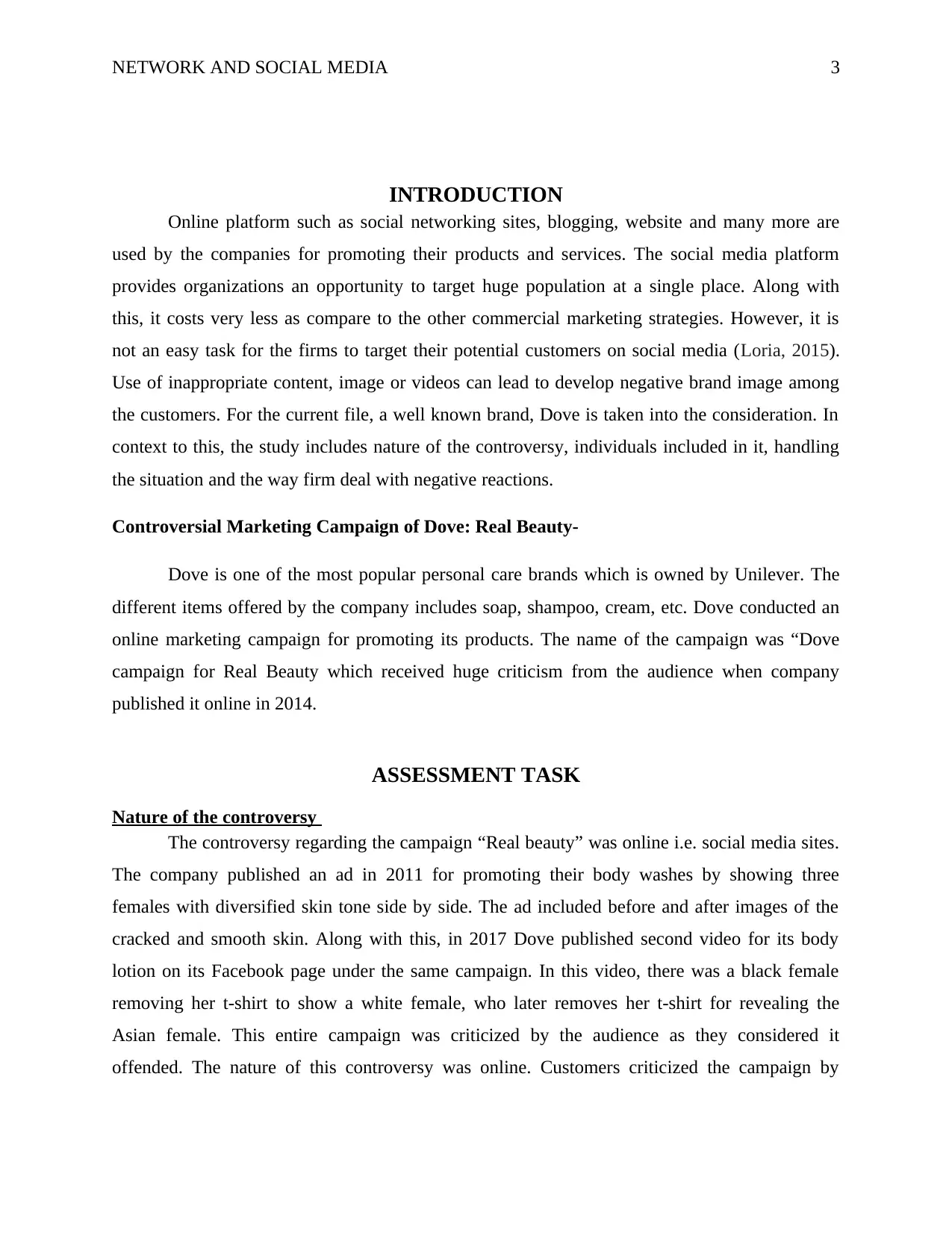
NETWORK AND SOCIAL MEDIA 3
INTRODUCTION
Online platform such as social networking sites, blogging, website and many more are
used by the companies for promoting their products and services. The social media platform
provides organizations an opportunity to target huge population at a single place. Along with
this, it costs very less as compare to the other commercial marketing strategies. However, it is
not an easy task for the firms to target their potential customers on social media (Loria, 2015).
Use of inappropriate content, image or videos can lead to develop negative brand image among
the customers. For the current file, a well known brand, Dove is taken into the consideration. In
context to this, the study includes nature of the controversy, individuals included in it, handling
the situation and the way firm deal with negative reactions.
Controversial Marketing Campaign of Dove: Real Beauty-
Dove is one of the most popular personal care brands which is owned by Unilever. The
different items offered by the company includes soap, shampoo, cream, etc. Dove conducted an
online marketing campaign for promoting its products. The name of the campaign was “Dove
campaign for Real Beauty which received huge criticism from the audience when company
published it online in 2014.
ASSESSMENT TASK
Nature of the controversy
The controversy regarding the campaign “Real beauty” was online i.e. social media sites.
The company published an ad in 2011 for promoting their body washes by showing three
females with diversified skin tone side by side. The ad included before and after images of the
cracked and smooth skin. Along with this, in 2017 Dove published second video for its body
lotion on its Facebook page under the same campaign. In this video, there was a black female
removing her t-shirt to show a white female, who later removes her t-shirt for revealing the
Asian female. This entire campaign was criticized by the audience as they considered it
offended. The nature of this controversy was online. Customers criticized the campaign by
INTRODUCTION
Online platform such as social networking sites, blogging, website and many more are
used by the companies for promoting their products and services. The social media platform
provides organizations an opportunity to target huge population at a single place. Along with
this, it costs very less as compare to the other commercial marketing strategies. However, it is
not an easy task for the firms to target their potential customers on social media (Loria, 2015).
Use of inappropriate content, image or videos can lead to develop negative brand image among
the customers. For the current file, a well known brand, Dove is taken into the consideration. In
context to this, the study includes nature of the controversy, individuals included in it, handling
the situation and the way firm deal with negative reactions.
Controversial Marketing Campaign of Dove: Real Beauty-
Dove is one of the most popular personal care brands which is owned by Unilever. The
different items offered by the company includes soap, shampoo, cream, etc. Dove conducted an
online marketing campaign for promoting its products. The name of the campaign was “Dove
campaign for Real Beauty which received huge criticism from the audience when company
published it online in 2014.
ASSESSMENT TASK
Nature of the controversy
The controversy regarding the campaign “Real beauty” was online i.e. social media sites.
The company published an ad in 2011 for promoting their body washes by showing three
females with diversified skin tone side by side. The ad included before and after images of the
cracked and smooth skin. Along with this, in 2017 Dove published second video for its body
lotion on its Facebook page under the same campaign. In this video, there was a black female
removing her t-shirt to show a white female, who later removes her t-shirt for revealing the
Asian female. This entire campaign was criticized by the audience as they considered it
offended. The nature of this controversy was online. Customers criticized the campaign by
⊘ This is a preview!⊘
Do you want full access?
Subscribe today to unlock all pages.

Trusted by 1+ million students worldwide
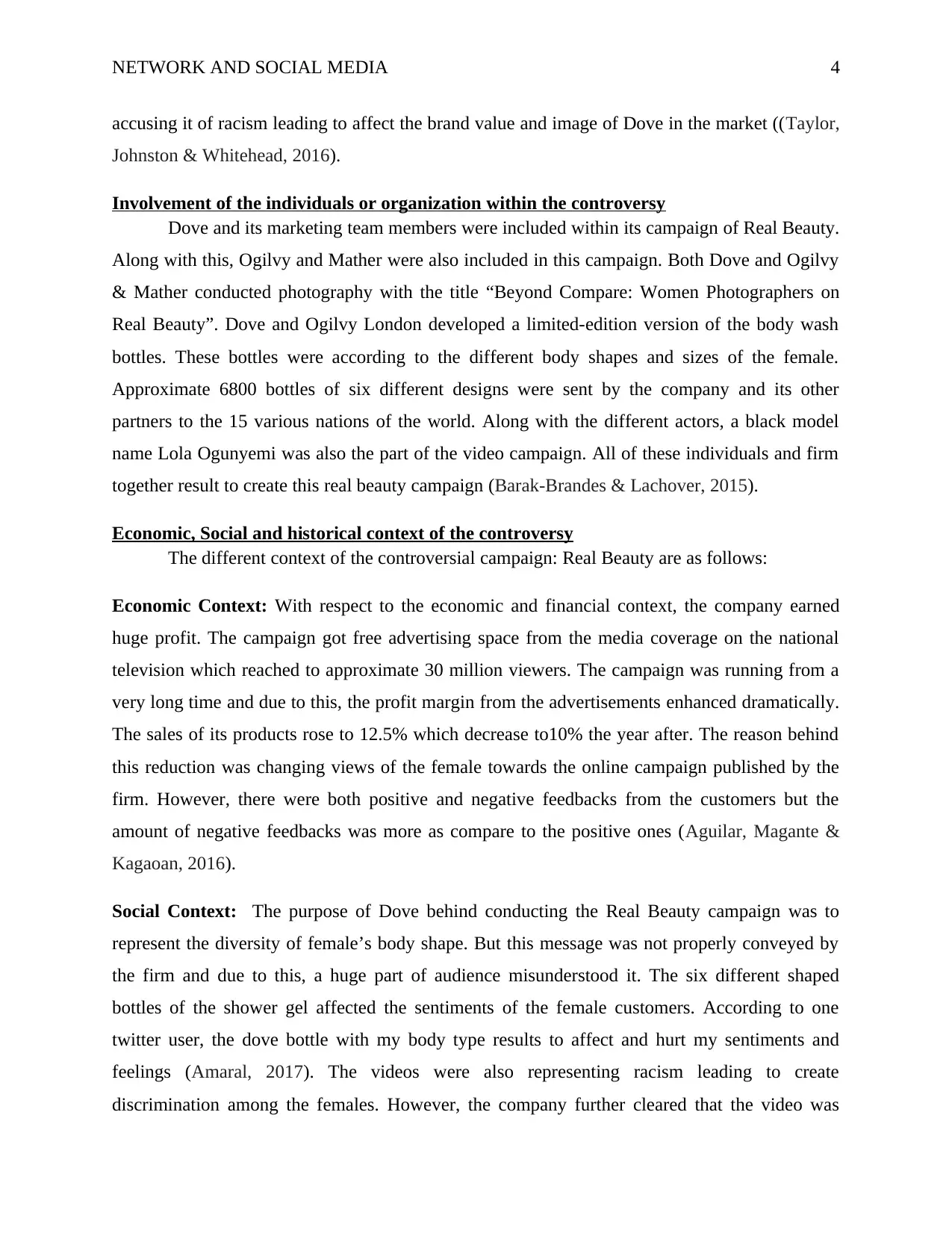
NETWORK AND SOCIAL MEDIA 4
accusing it of racism leading to affect the brand value and image of Dove in the market ((Taylor,
Johnston & Whitehead, 2016).
Involvement of the individuals or organization within the controversy
Dove and its marketing team members were included within its campaign of Real Beauty.
Along with this, Ogilvy and Mather were also included in this campaign. Both Dove and Ogilvy
& Mather conducted photography with the title “Beyond Compare: Women Photographers on
Real Beauty”. Dove and Ogilvy London developed a limited-edition version of the body wash
bottles. These bottles were according to the different body shapes and sizes of the female.
Approximate 6800 bottles of six different designs were sent by the company and its other
partners to the 15 various nations of the world. Along with the different actors, a black model
name Lola Ogunyemi was also the part of the video campaign. All of these individuals and firm
together result to create this real beauty campaign (Barak-Brandes & Lachover, 2015).
Economic, Social and historical context of the controversy
The different context of the controversial campaign: Real Beauty are as follows:
Economic Context: With respect to the economic and financial context, the company earned
huge profit. The campaign got free advertising space from the media coverage on the national
television which reached to approximate 30 million viewers. The campaign was running from a
very long time and due to this, the profit margin from the advertisements enhanced dramatically.
The sales of its products rose to 12.5% which decrease to10% the year after. The reason behind
this reduction was changing views of the female towards the online campaign published by the
firm. However, there were both positive and negative feedbacks from the customers but the
amount of negative feedbacks was more as compare to the positive ones (Aguilar, Magante &
Kagaoan, 2016).
Social Context: The purpose of Dove behind conducting the Real Beauty campaign was to
represent the diversity of female’s body shape. But this message was not properly conveyed by
the firm and due to this, a huge part of audience misunderstood it. The six different shaped
bottles of the shower gel affected the sentiments of the female customers. According to one
twitter user, the dove bottle with my body type results to affect and hurt my sentiments and
feelings (Amaral, 2017). The videos were also representing racism leading to create
discrimination among the females. However, the company further cleared that the video was
accusing it of racism leading to affect the brand value and image of Dove in the market ((Taylor,
Johnston & Whitehead, 2016).
Involvement of the individuals or organization within the controversy
Dove and its marketing team members were included within its campaign of Real Beauty.
Along with this, Ogilvy and Mather were also included in this campaign. Both Dove and Ogilvy
& Mather conducted photography with the title “Beyond Compare: Women Photographers on
Real Beauty”. Dove and Ogilvy London developed a limited-edition version of the body wash
bottles. These bottles were according to the different body shapes and sizes of the female.
Approximate 6800 bottles of six different designs were sent by the company and its other
partners to the 15 various nations of the world. Along with the different actors, a black model
name Lola Ogunyemi was also the part of the video campaign. All of these individuals and firm
together result to create this real beauty campaign (Barak-Brandes & Lachover, 2015).
Economic, Social and historical context of the controversy
The different context of the controversial campaign: Real Beauty are as follows:
Economic Context: With respect to the economic and financial context, the company earned
huge profit. The campaign got free advertising space from the media coverage on the national
television which reached to approximate 30 million viewers. The campaign was running from a
very long time and due to this, the profit margin from the advertisements enhanced dramatically.
The sales of its products rose to 12.5% which decrease to10% the year after. The reason behind
this reduction was changing views of the female towards the online campaign published by the
firm. However, there were both positive and negative feedbacks from the customers but the
amount of negative feedbacks was more as compare to the positive ones (Aguilar, Magante &
Kagaoan, 2016).
Social Context: The purpose of Dove behind conducting the Real Beauty campaign was to
represent the diversity of female’s body shape. But this message was not properly conveyed by
the firm and due to this, a huge part of audience misunderstood it. The six different shaped
bottles of the shower gel affected the sentiments of the female customers. According to one
twitter user, the dove bottle with my body type results to affect and hurt my sentiments and
feelings (Amaral, 2017). The videos were also representing racism leading to create
discrimination among the females. However, the company further cleared that the video was
Paraphrase This Document
Need a fresh take? Get an instant paraphrase of this document with our AI Paraphraser
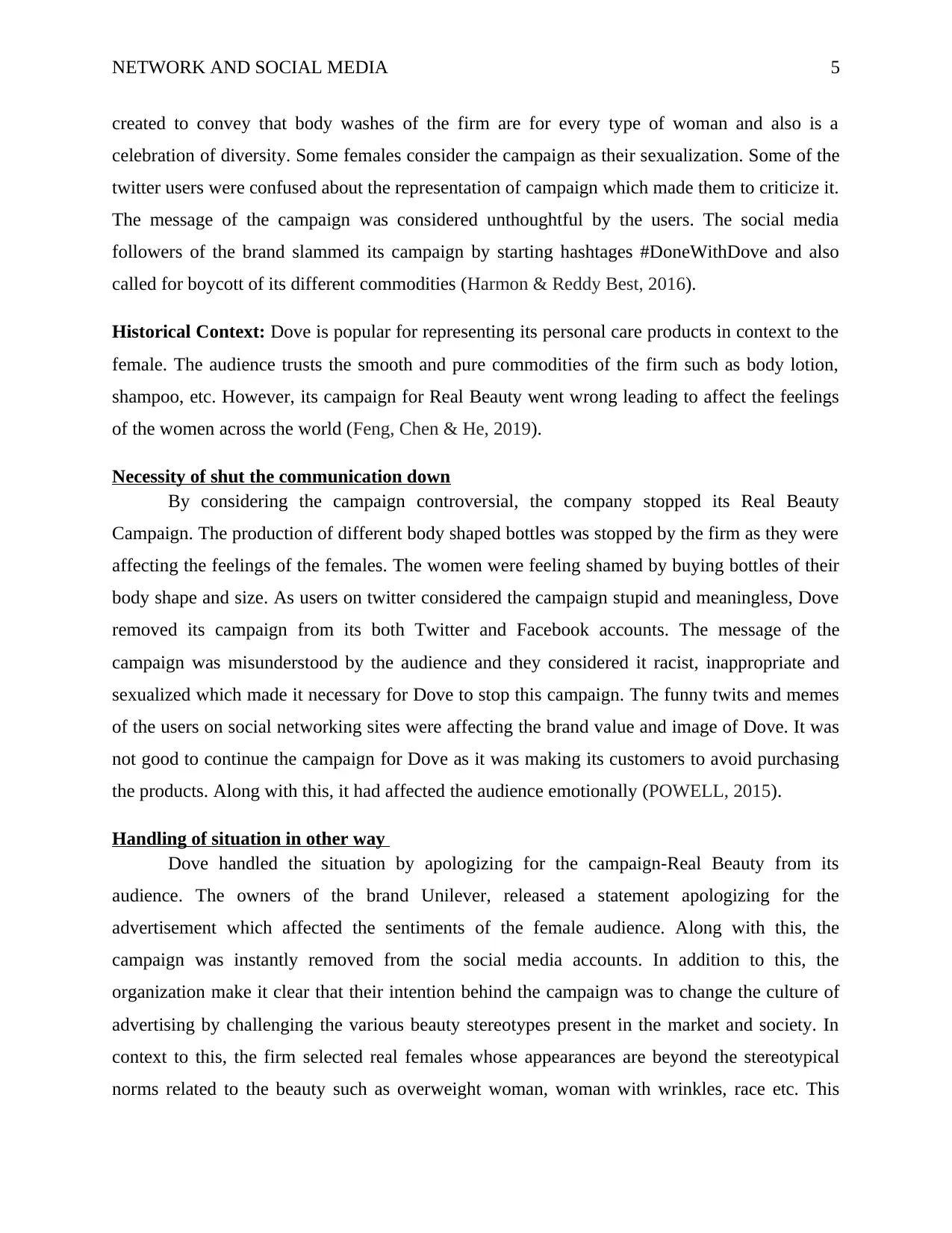
NETWORK AND SOCIAL MEDIA 5
created to convey that body washes of the firm are for every type of woman and also is a
celebration of diversity. Some females consider the campaign as their sexualization. Some of the
twitter users were confused about the representation of campaign which made them to criticize it.
The message of the campaign was considered unthoughtful by the users. The social media
followers of the brand slammed its campaign by starting hashtages #DoneWithDove and also
called for boycott of its different commodities (Harmon & Reddy Best, 2016).
Historical Context: Dove is popular for representing its personal care products in context to the
female. The audience trusts the smooth and pure commodities of the firm such as body lotion,
shampoo, etc. However, its campaign for Real Beauty went wrong leading to affect the feelings
of the women across the world (Feng, Chen & He, 2019).
Necessity of shut the communication down
By considering the campaign controversial, the company stopped its Real Beauty
Campaign. The production of different body shaped bottles was stopped by the firm as they were
affecting the feelings of the females. The women were feeling shamed by buying bottles of their
body shape and size. As users on twitter considered the campaign stupid and meaningless, Dove
removed its campaign from its both Twitter and Facebook accounts. The message of the
campaign was misunderstood by the audience and they considered it racist, inappropriate and
sexualized which made it necessary for Dove to stop this campaign. The funny twits and memes
of the users on social networking sites were affecting the brand value and image of Dove. It was
not good to continue the campaign for Dove as it was making its customers to avoid purchasing
the products. Along with this, it had affected the audience emotionally (POWELL, 2015).
Handling of situation in other way
Dove handled the situation by apologizing for the campaign-Real Beauty from its
audience. The owners of the brand Unilever, released a statement apologizing for the
advertisement which affected the sentiments of the female audience. Along with this, the
campaign was instantly removed from the social media accounts. In addition to this, the
organization make it clear that their intention behind the campaign was to change the culture of
advertising by challenging the various beauty stereotypes present in the market and society. In
context to this, the firm selected real females whose appearances are beyond the stereotypical
norms related to the beauty such as overweight woman, woman with wrinkles, race etc. This
created to convey that body washes of the firm are for every type of woman and also is a
celebration of diversity. Some females consider the campaign as their sexualization. Some of the
twitter users were confused about the representation of campaign which made them to criticize it.
The message of the campaign was considered unthoughtful by the users. The social media
followers of the brand slammed its campaign by starting hashtages #DoneWithDove and also
called for boycott of its different commodities (Harmon & Reddy Best, 2016).
Historical Context: Dove is popular for representing its personal care products in context to the
female. The audience trusts the smooth and pure commodities of the firm such as body lotion,
shampoo, etc. However, its campaign for Real Beauty went wrong leading to affect the feelings
of the women across the world (Feng, Chen & He, 2019).
Necessity of shut the communication down
By considering the campaign controversial, the company stopped its Real Beauty
Campaign. The production of different body shaped bottles was stopped by the firm as they were
affecting the feelings of the females. The women were feeling shamed by buying bottles of their
body shape and size. As users on twitter considered the campaign stupid and meaningless, Dove
removed its campaign from its both Twitter and Facebook accounts. The message of the
campaign was misunderstood by the audience and they considered it racist, inappropriate and
sexualized which made it necessary for Dove to stop this campaign. The funny twits and memes
of the users on social networking sites were affecting the brand value and image of Dove. It was
not good to continue the campaign for Dove as it was making its customers to avoid purchasing
the products. Along with this, it had affected the audience emotionally (POWELL, 2015).
Handling of situation in other way
Dove handled the situation by apologizing for the campaign-Real Beauty from its
audience. The owners of the brand Unilever, released a statement apologizing for the
advertisement which affected the sentiments of the female audience. Along with this, the
campaign was instantly removed from the social media accounts. In addition to this, the
organization make it clear that their intention behind the campaign was to change the culture of
advertising by challenging the various beauty stereotypes present in the market and society. In
context to this, the firm selected real females whose appearances are beyond the stereotypical
norms related to the beauty such as overweight woman, woman with wrinkles, race etc. This
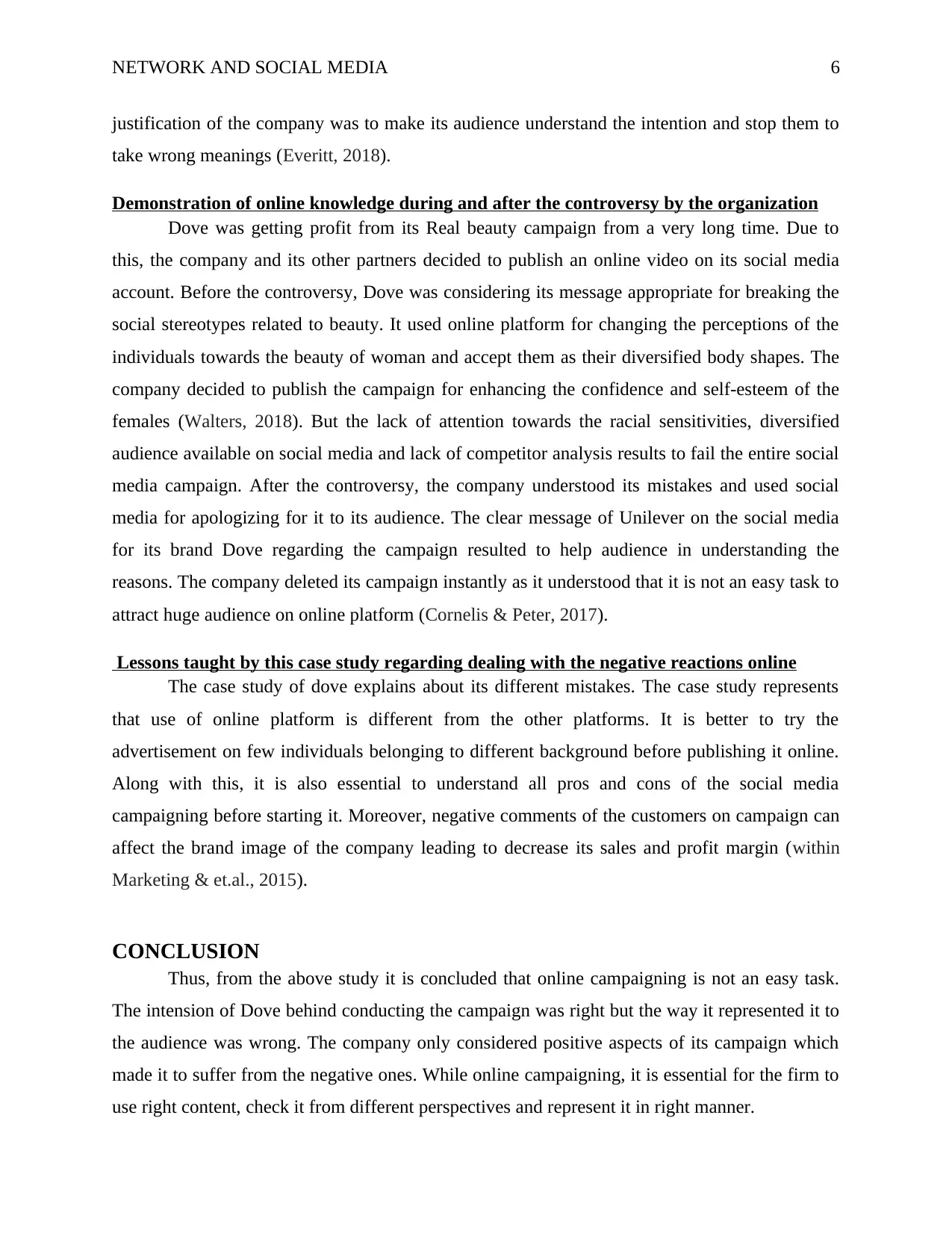
NETWORK AND SOCIAL MEDIA 6
justification of the company was to make its audience understand the intention and stop them to
take wrong meanings (Everitt, 2018).
Demonstration of online knowledge during and after the controversy by the organization
Dove was getting profit from its Real beauty campaign from a very long time. Due to
this, the company and its other partners decided to publish an online video on its social media
account. Before the controversy, Dove was considering its message appropriate for breaking the
social stereotypes related to beauty. It used online platform for changing the perceptions of the
individuals towards the beauty of woman and accept them as their diversified body shapes. The
company decided to publish the campaign for enhancing the confidence and self-esteem of the
females (Walters, 2018). But the lack of attention towards the racial sensitivities, diversified
audience available on social media and lack of competitor analysis results to fail the entire social
media campaign. After the controversy, the company understood its mistakes and used social
media for apologizing for it to its audience. The clear message of Unilever on the social media
for its brand Dove regarding the campaign resulted to help audience in understanding the
reasons. The company deleted its campaign instantly as it understood that it is not an easy task to
attract huge audience on online platform (Cornelis & Peter, 2017).
Lessons taught by this case study regarding dealing with the negative reactions online
The case study of dove explains about its different mistakes. The case study represents
that use of online platform is different from the other platforms. It is better to try the
advertisement on few individuals belonging to different background before publishing it online.
Along with this, it is also essential to understand all pros and cons of the social media
campaigning before starting it. Moreover, negative comments of the customers on campaign can
affect the brand image of the company leading to decrease its sales and profit margin (within
Marketing & et.al., 2015).
CONCLUSION
Thus, from the above study it is concluded that online campaigning is not an easy task.
The intension of Dove behind conducting the campaign was right but the way it represented it to
the audience was wrong. The company only considered positive aspects of its campaign which
made it to suffer from the negative ones. While online campaigning, it is essential for the firm to
use right content, check it from different perspectives and represent it in right manner.
justification of the company was to make its audience understand the intention and stop them to
take wrong meanings (Everitt, 2018).
Demonstration of online knowledge during and after the controversy by the organization
Dove was getting profit from its Real beauty campaign from a very long time. Due to
this, the company and its other partners decided to publish an online video on its social media
account. Before the controversy, Dove was considering its message appropriate for breaking the
social stereotypes related to beauty. It used online platform for changing the perceptions of the
individuals towards the beauty of woman and accept them as their diversified body shapes. The
company decided to publish the campaign for enhancing the confidence and self-esteem of the
females (Walters, 2018). But the lack of attention towards the racial sensitivities, diversified
audience available on social media and lack of competitor analysis results to fail the entire social
media campaign. After the controversy, the company understood its mistakes and used social
media for apologizing for it to its audience. The clear message of Unilever on the social media
for its brand Dove regarding the campaign resulted to help audience in understanding the
reasons. The company deleted its campaign instantly as it understood that it is not an easy task to
attract huge audience on online platform (Cornelis & Peter, 2017).
Lessons taught by this case study regarding dealing with the negative reactions online
The case study of dove explains about its different mistakes. The case study represents
that use of online platform is different from the other platforms. It is better to try the
advertisement on few individuals belonging to different background before publishing it online.
Along with this, it is also essential to understand all pros and cons of the social media
campaigning before starting it. Moreover, negative comments of the customers on campaign can
affect the brand image of the company leading to decrease its sales and profit margin (within
Marketing & et.al., 2015).
CONCLUSION
Thus, from the above study it is concluded that online campaigning is not an easy task.
The intension of Dove behind conducting the campaign was right but the way it represented it to
the audience was wrong. The company only considered positive aspects of its campaign which
made it to suffer from the negative ones. While online campaigning, it is essential for the firm to
use right content, check it from different perspectives and represent it in right manner.
⊘ This is a preview!⊘
Do you want full access?
Subscribe today to unlock all pages.

Trusted by 1+ million students worldwide
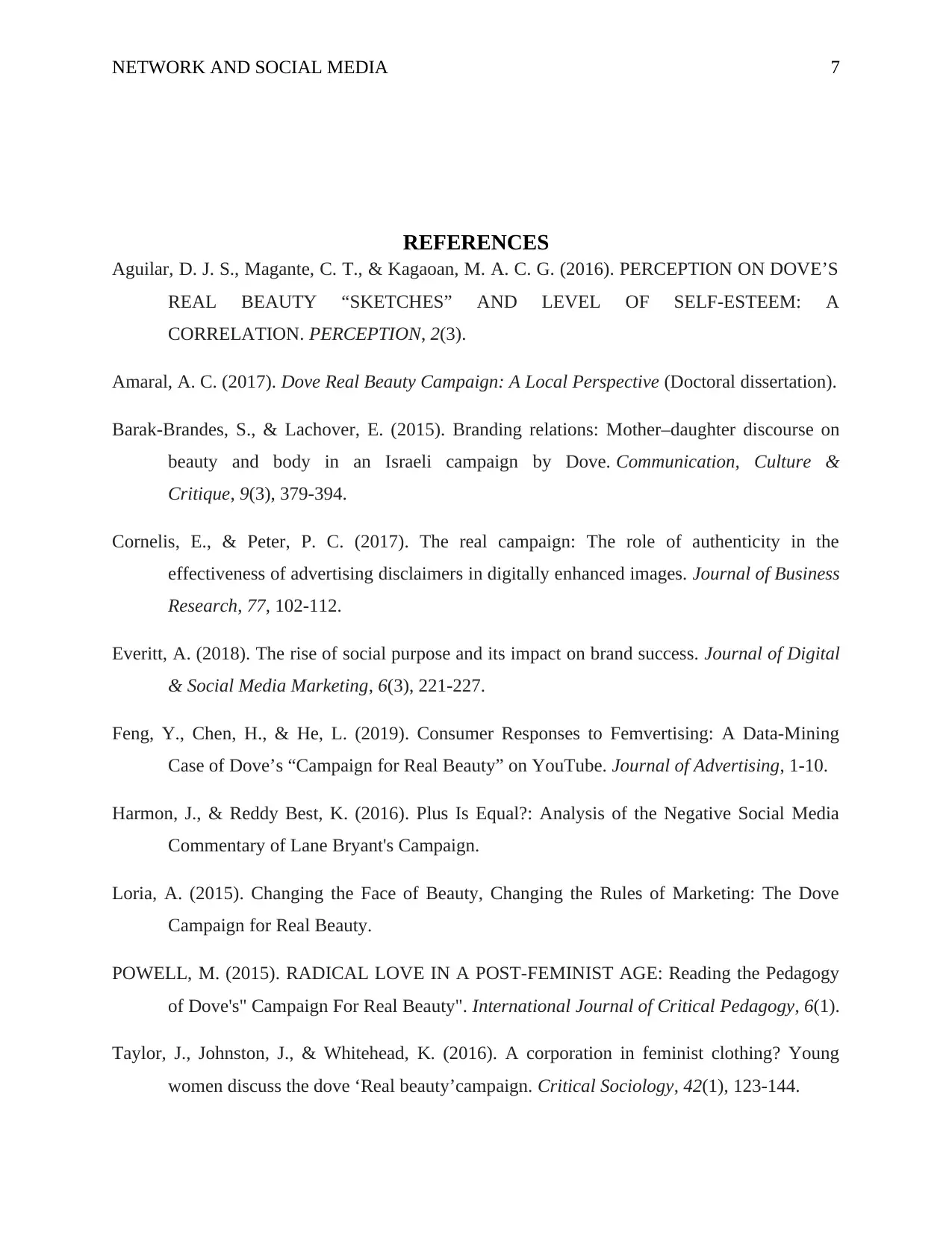
NETWORK AND SOCIAL MEDIA 7
REFERENCES
Aguilar, D. J. S., Magante, C. T., & Kagaoan, M. A. C. G. (2016). PERCEPTION ON DOVE’S
REAL BEAUTY “SKETCHES” AND LEVEL OF SELF-ESTEEM: A
CORRELATION. PERCEPTION, 2(3).
Amaral, A. C. (2017). Dove Real Beauty Campaign: A Local Perspective (Doctoral dissertation).
Barak-Brandes, S., & Lachover, E. (2015). Branding relations: Mother–daughter discourse on
beauty and body in an Israeli campaign by Dove. Communication, Culture &
Critique, 9(3), 379-394.
Cornelis, E., & Peter, P. C. (2017). The real campaign: The role of authenticity in the
effectiveness of advertising disclaimers in digitally enhanced images. Journal of Business
Research, 77, 102-112.
Everitt, A. (2018). The rise of social purpose and its impact on brand success. Journal of Digital
& Social Media Marketing, 6(3), 221-227.
Feng, Y., Chen, H., & He, L. (2019). Consumer Responses to Femvertising: A Data-Mining
Case of Dove’s “Campaign for Real Beauty” on YouTube. Journal of Advertising, 1-10.
Harmon, J., & Reddy Best, K. (2016). Plus Is Equal?: Analysis of the Negative Social Media
Commentary of Lane Bryant's Campaign.
Loria, A. (2015). Changing the Face of Beauty, Changing the Rules of Marketing: The Dove
Campaign for Real Beauty.
POWELL, M. (2015). RADICAL LOVE IN A POST-FEMINIST AGE: Reading the Pedagogy
of Dove's" Campaign For Real Beauty". International Journal of Critical Pedagogy, 6(1).
Taylor, J., Johnston, J., & Whitehead, K. (2016). A corporation in feminist clothing? Young
women discuss the dove ‘Real beauty’campaign. Critical Sociology, 42(1), 123-144.
REFERENCES
Aguilar, D. J. S., Magante, C. T., & Kagaoan, M. A. C. G. (2016). PERCEPTION ON DOVE’S
REAL BEAUTY “SKETCHES” AND LEVEL OF SELF-ESTEEM: A
CORRELATION. PERCEPTION, 2(3).
Amaral, A. C. (2017). Dove Real Beauty Campaign: A Local Perspective (Doctoral dissertation).
Barak-Brandes, S., & Lachover, E. (2015). Branding relations: Mother–daughter discourse on
beauty and body in an Israeli campaign by Dove. Communication, Culture &
Critique, 9(3), 379-394.
Cornelis, E., & Peter, P. C. (2017). The real campaign: The role of authenticity in the
effectiveness of advertising disclaimers in digitally enhanced images. Journal of Business
Research, 77, 102-112.
Everitt, A. (2018). The rise of social purpose and its impact on brand success. Journal of Digital
& Social Media Marketing, 6(3), 221-227.
Feng, Y., Chen, H., & He, L. (2019). Consumer Responses to Femvertising: A Data-Mining
Case of Dove’s “Campaign for Real Beauty” on YouTube. Journal of Advertising, 1-10.
Harmon, J., & Reddy Best, K. (2016). Plus Is Equal?: Analysis of the Negative Social Media
Commentary of Lane Bryant's Campaign.
Loria, A. (2015). Changing the Face of Beauty, Changing the Rules of Marketing: The Dove
Campaign for Real Beauty.
POWELL, M. (2015). RADICAL LOVE IN A POST-FEMINIST AGE: Reading the Pedagogy
of Dove's" Campaign For Real Beauty". International Journal of Critical Pedagogy, 6(1).
Taylor, J., Johnston, J., & Whitehead, K. (2016). A corporation in feminist clothing? Young
women discuss the dove ‘Real beauty’campaign. Critical Sociology, 42(1), 123-144.
Paraphrase This Document
Need a fresh take? Get an instant paraphrase of this document with our AI Paraphraser
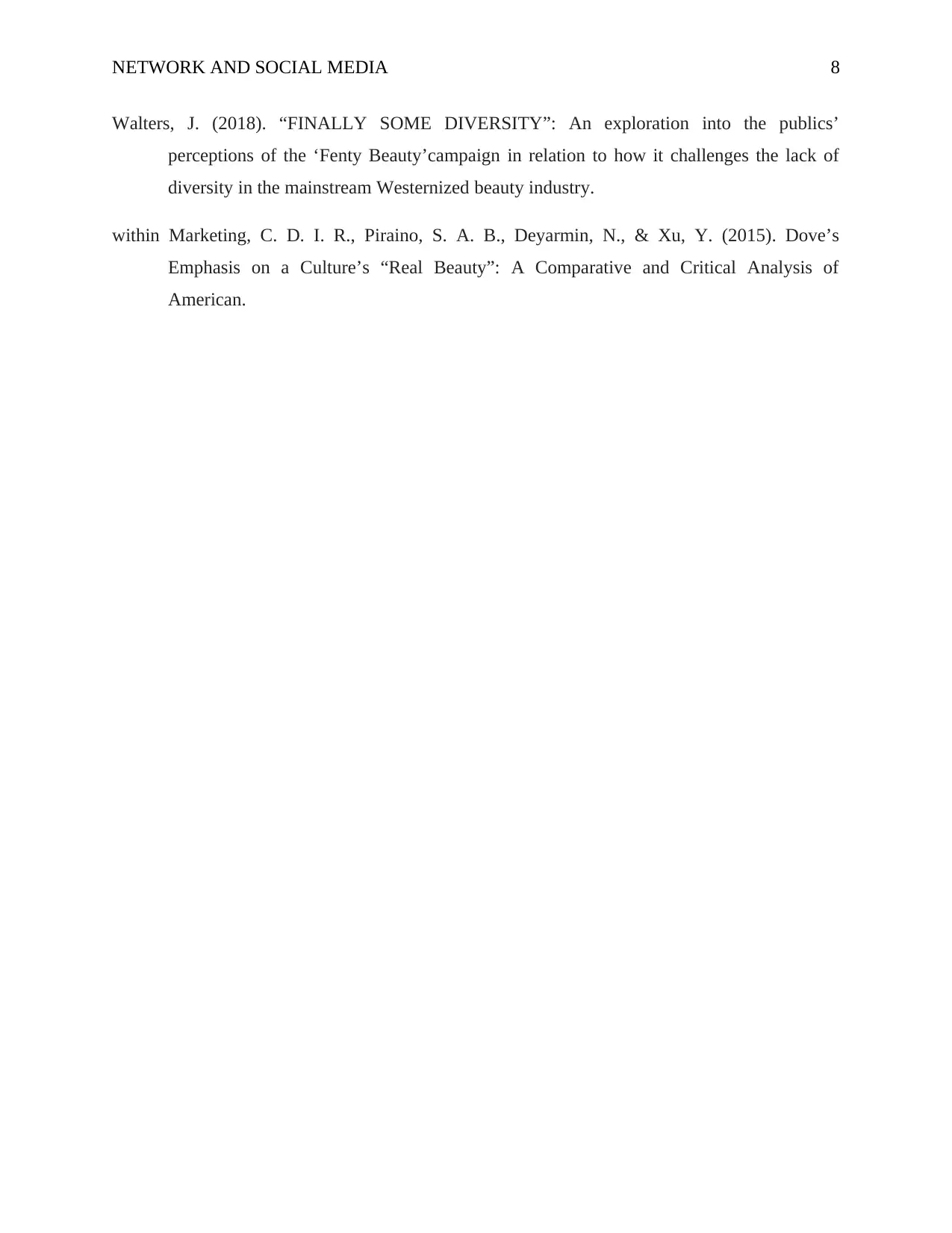
NETWORK AND SOCIAL MEDIA 8
Walters, J. (2018). “FINALLY SOME DIVERSITY”: An exploration into the publics’
perceptions of the ‘Fenty Beauty’campaign in relation to how it challenges the lack of
diversity in the mainstream Westernized beauty industry.
within Marketing, C. D. I. R., Piraino, S. A. B., Deyarmin, N., & Xu, Y. (2015). Dove’s
Emphasis on a Culture’s “Real Beauty”: A Comparative and Critical Analysis of
American.
Walters, J. (2018). “FINALLY SOME DIVERSITY”: An exploration into the publics’
perceptions of the ‘Fenty Beauty’campaign in relation to how it challenges the lack of
diversity in the mainstream Westernized beauty industry.
within Marketing, C. D. I. R., Piraino, S. A. B., Deyarmin, N., & Xu, Y. (2015). Dove’s
Emphasis on a Culture’s “Real Beauty”: A Comparative and Critical Analysis of
American.
1 out of 8
Related Documents
Your All-in-One AI-Powered Toolkit for Academic Success.
+13062052269
info@desklib.com
Available 24*7 on WhatsApp / Email
![[object Object]](/_next/static/media/star-bottom.7253800d.svg)
Unlock your academic potential
Copyright © 2020–2025 A2Z Services. All Rights Reserved. Developed and managed by ZUCOL.





